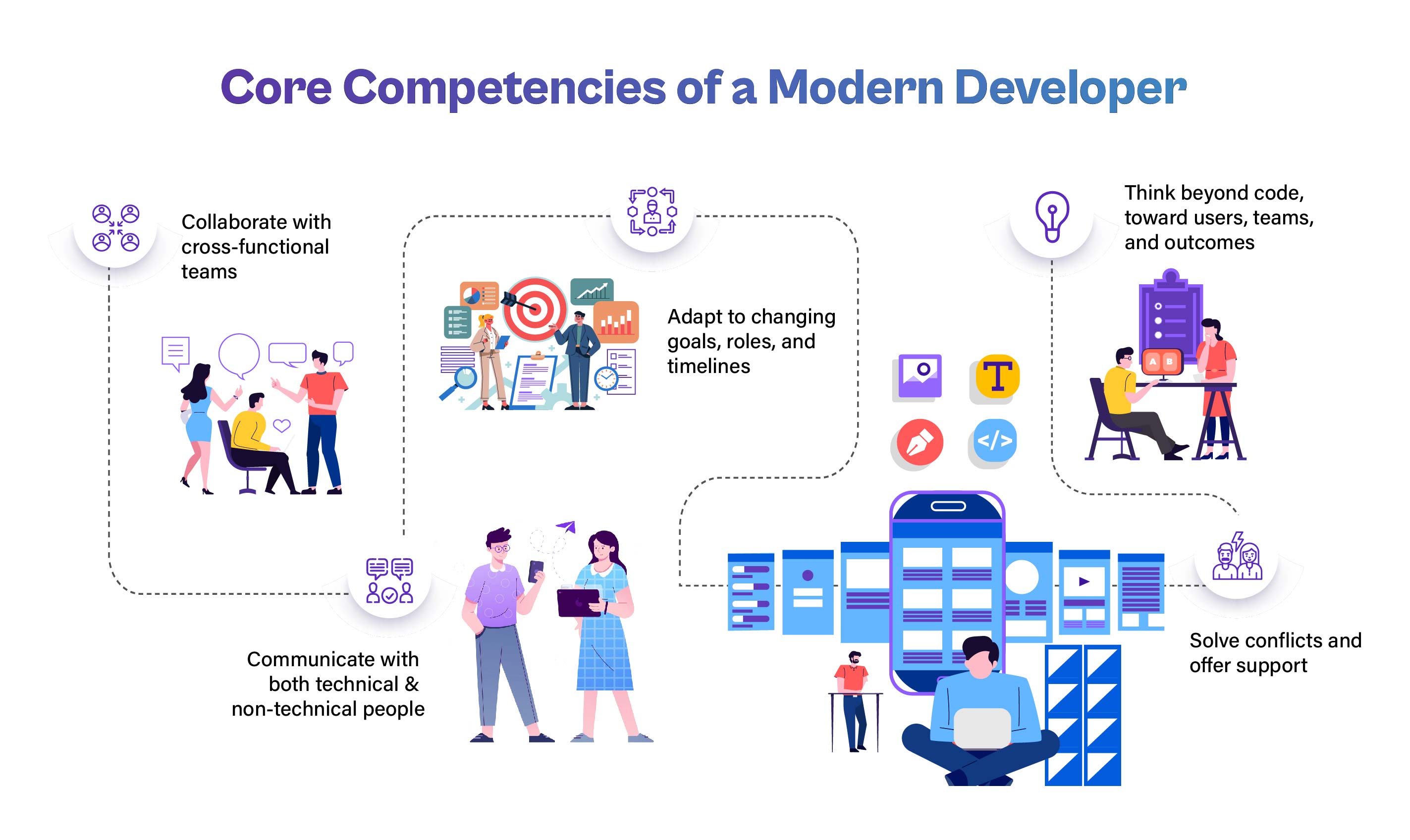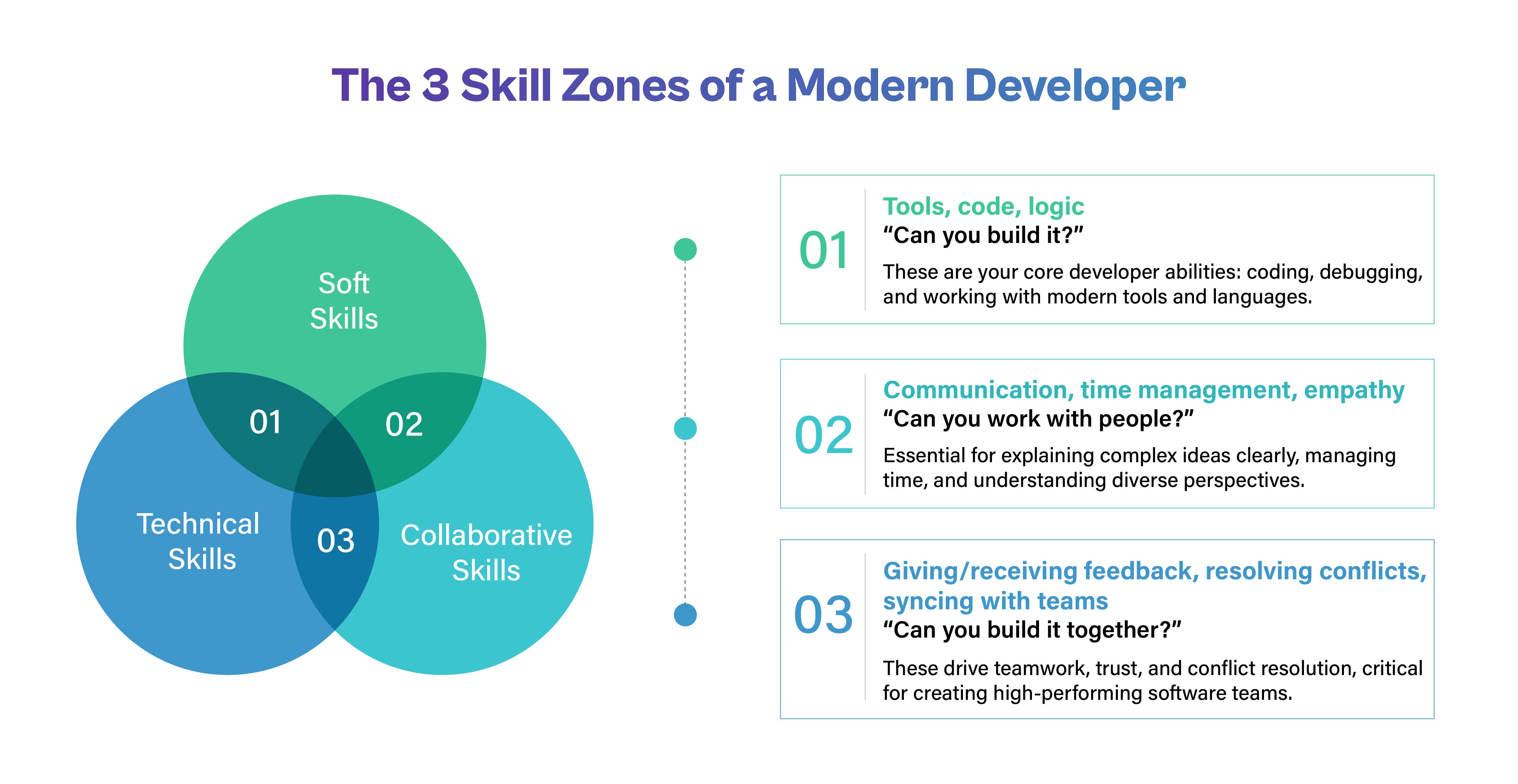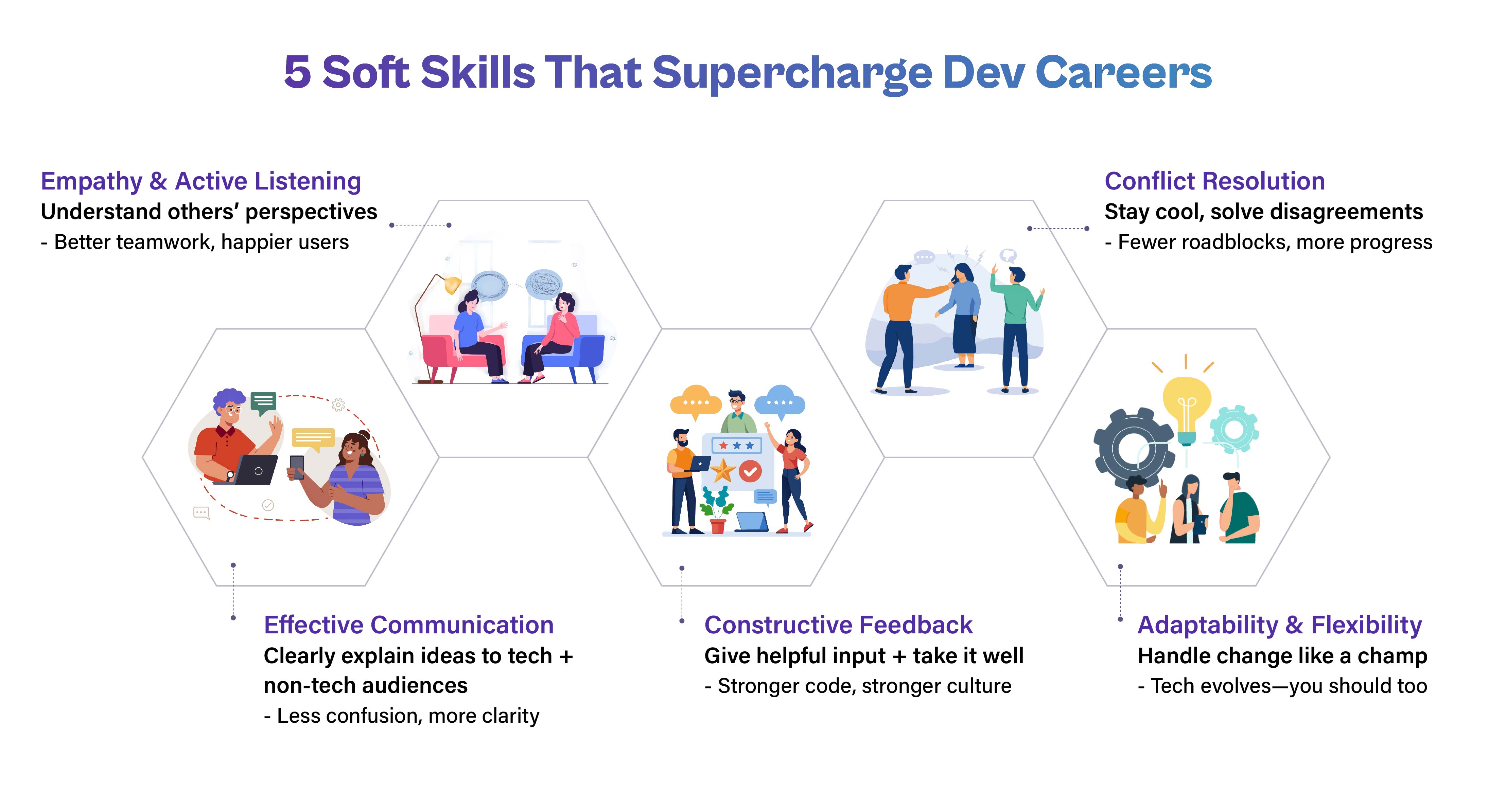




“Coding is only half the story. To thrive as a developer today, you need more than just technical skills, you need the power to work brilliantly with people.”
If you’re studying computer science or teaching yourself to code, you’re probably picturing a future filled with solving challenging algorithms, building innovative apps, and writing clean, efficient code. These technical skills are undeniably essential for any successful software developer.
However, there’s a crucial truth that many students and aspiring developers often overlook: technical expertise alone isn’t enough in the modern technology industry.
Today’s software development landscape is built on collaboration, communication, and adaptability. Employers are actively searching for developers who can work effectively in cross-functional teams, explain complex ideas clearly, and respond confidently to changing project requirements and business needs.

This emphasis reflects how the industry has evolved. Modern software projects are no longer solo efforts; they’re created by teams that blend the skills of developers, designers, product managers, data scientists, quality assurance engineers, and business stakeholders. Research confirms this shift: a McKinsey report found that high-performing software teams are up to 2.6 times more productive than lower-performing ones, not solely due to technical prowess but because of how well team members collaborate and communicate.
In the real world:
Modern employers value skills like effective communication, empathy, problem-solving, conflict resolution, and adaptability just as highly, if not more than pure coding talent. These are known as collaborative skills and soft skills, and they’re critical for anyone aiming to succeed in today’s fast-paced, innovation-driven software industry.
In this blog, we’ll explore exactly what collaborative and soft skills mean for developers, why they’re so vital in the tech industry, and the five essential collaboration skills every student and aspiring developer should develop. Whether you’re working on a class project, contributing to open-source communities, or preparing for your first job, mastering these skills will help you become a valuable, high-impact team member ready to thrive in your future career.
In the field of software development, success relies not only on writing efficient code or mastering technical tools but also on how effectively professionals work with others. This is where collaborative skills and soft skills become crucial.

While technical skills answer the question, “Can you build it?”, collaborative and soft skills answer, “Can you build it together, and deliver it successfully as part of a team?”
Modern software development is highly collaborative by nature. Projects typically involve multiple professionals working together, including:
This interconnected environment demands strong collaborative and soft skills to ensure:
Research reinforces this emphasis on collaboration. For instance, McKinsey & Company (2021) reported that high-performing software teams are up to 2.6 times more productive than lower-performing teams, largely because of stronger communication and collaborative practices. This finding highlights that technical skills alone do not guarantee success; the ability to work well with others is a key driver of high performance in software development.
Moreover, data from the Stack Overflow Developer Survey (2022) indicates that developers spend between 35% and 50% of their working time collaborating with others, through meetings, code reviews, pair programming, or discussing solutions. This statistic underlines the reality that collaboration is not a side activity but a significant part of daily work for developers.
These skills manifest in numerous ways in everyday professional situations. For example:
In the evolving tech industry, success hinges not just on how well you code, but on how effectively you work with people. Mastering these five collaboration skills will give students and aspiring developers a significant advantage in building meaningful, impactful careers.

Effective communication means conveying your ideas clearly, concisely, and appropriately for your audience, whether you’re discussing technical details with fellow engineers or explaining project status to non-technical stakeholders.
It’s not just about talking, it includes listening actively, writing precisely, and choosing the right channels for different messages.
A report by The Economist Intelligence Unit found that 44% of employees identify poor communication as the primary cause of project delays or failures.⁵ Good communication is not optional, it’s fundamental to project success.
At Slack Technologies, engineers frequently collaborate with customer success teams to refine product features. Technical staff must explain API changes in simple, user-friendly language so non-technical colleagues can help customers effectively. Poor communication could result in frustrated users and churn, a direct business impact.
Empathy is the ability to understand and share the feelings and perspectives of others. Active listening means being fully present, paying attention, and responding thoughtfully rather than merely waiting for your turn to speak.
Together, these skills create strong professional relationships and foster a positive, collaborative environment.
The DDI Global Leadership Forecast found that teams high in empathy are 50% more innovative and agile.⁶ Understanding others’ views leads to solutions that work for everyone.
At Microsoft, developers working on the Accessibility team must have a deep understanding of the experiences of users with disabilities. Empathy is crucial in designing inclusive products, such as screen readers and voice navigation tools. Without it, essential user needs could be overlooked, thereby limiting the product's reach and usability.
Constructive feedback involves providing specific, actionable insights designed to help others improve. Equally important is being open and receptive when you receive feedback yourself.
Constructive feedback is honest but respectful, it focuses on the work, not the individual.
According to Officevibe’s State of Employee Engagement report, 69% of employees would work harder if they felt their efforts were better recognized and guided.⁷ Feedback motivates and develops talent.
At Facebook (Meta), code reviews are an essential part of the development process. Engineers are expected to review each other’s code constructively, pointing out potential improvements without criticism that feels personal. This practice raises overall code quality and fosters a culture of learning and mutual respect.
Conflict resolution involves navigating disagreements calmly and professionally, finding solutions that satisfy all parties whenever possible.
Conflict is natural in any collaborative environment, especially in creative fields like software development. The key is handling it constructively rather than avoiding it or letting it escalate.
A research by CPP Inc. (2008) shows that poorly managed conflict costs U.S. businesses $359 billion annually in lost productivity.⁸
At IBM, teams use formal conflict resolution frameworks during project retrospectives. If team members disagree about how to approach a problem, a facilitator helps guide the discussion toward mutual understanding rather than leaving tensions unresolved. This structured approach ensures disputes don’t jeopardize future collaboration.
Adaptability and flexibility refer to a developer’s willingness and ability to adjust to changing circumstances, requirements, tools, or technologies.
In an industry as fast-paced as tech, change is constant, whether it’s a new programming language, shifting project priorities, or evolving user expectations.
In a Deloitte Insights survey (2021), adaptability was named the #1 soft skill companies value most. Employers want team members who stay effective even when circumstances shift.
During the COVID-19 pandemic, Salesforce rapidly pivoted to support new customer needs, including tools for remote work and health tracking. Developers had to quickly shift priorities, learn new technologies, and adapt to unprecedented circumstances. Adaptable engineers enabled the company to respond effectively to market changes.
The modern software industry doesn’t just value how well you can write code, it values how well you work with people to build something meaningful.
As technology continues to evolve, developers who combine technical expertise with strong collaborative and soft skills will be the ones who stand out, advance in their careers, and help create innovative solutions that shape the future.
By developing skills like effective communication, empathy and active listening, constructive feedback, conflict resolution, and adaptability, you’ll position yourself as a versatile, high-impact contributor who can thrive in diverse teams and navigate the fast-changing landscape of the tech world.
At the end of the day, great software isn’t built by individuals, it’s built by teams. Invest in these essential skills alongside your technical learning, and you’ll be ready to take your place in the industry as not just a skilled coder, but a true collaborator and innovator.
At Cogent University, our programs blend rigorous coding training with hands-on teamwork workshops.Join us to become not just a coder, but a confident collaborator who drives innovation from day one.
Enroll now and transform your potential into impact!
The rich text element allows you to create and format headings, paragraphs, blockquotes, images, and video all in one place instead of having to add and format them individually. Just double-click and easily create content.
A rich text element can be used with static or dynamic content. For static content, just drop it into any page and begin editing. For dynamic content, add a rich text field to any collection and then connect a rich text element to that field in the settings panel. Voila!
Headings, paragraphs, blockquotes, figures, images, and figure captions can all be styled after a class is added to the rich text element using the "When inside of" nested selector system.
Ever wondered how computer programming works, but haven't done anything more complicated on the web than upload a photo to Facebook?
Then you're in the right place.
To someone who's never coded before, the concept of creating a website from scratch -- layout, design, and all -- can seem really intimidating. You might be picturing Harvard students from the movie, The Social Network, sitting at their computers with gigantic headphones on and hammering out code, and think to yourself, 'I could never do that.
'Actually, you can. ad phones on and hammering out code, and think to yourself, 'I could never do that.'
